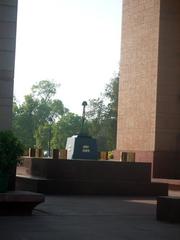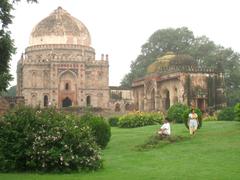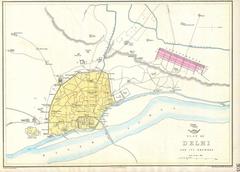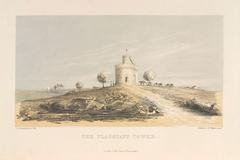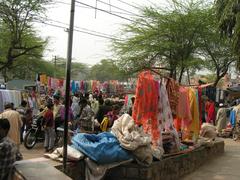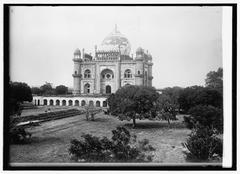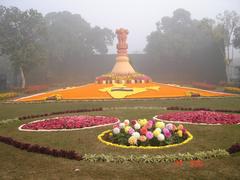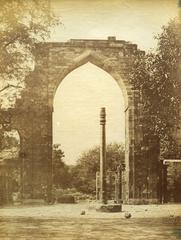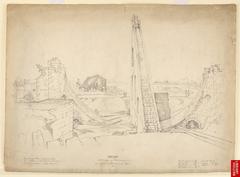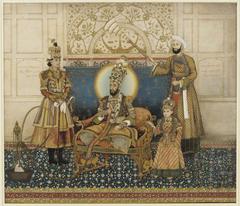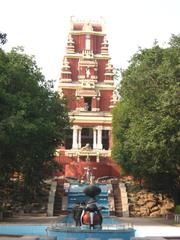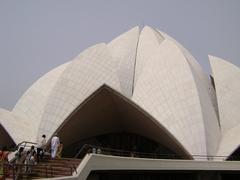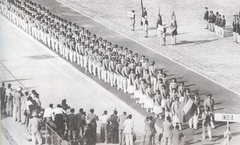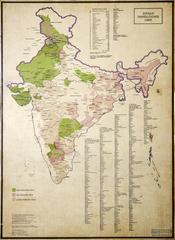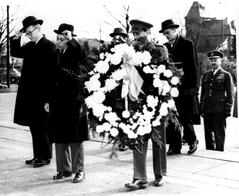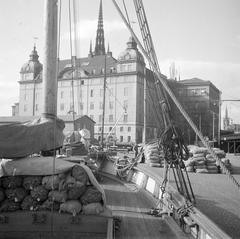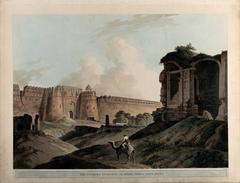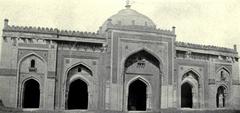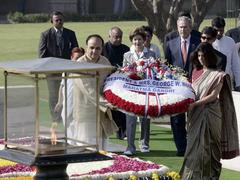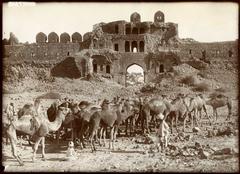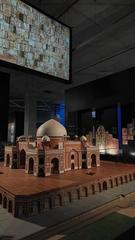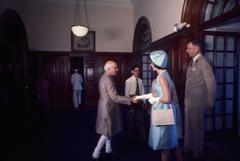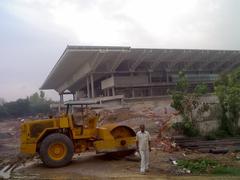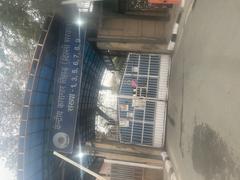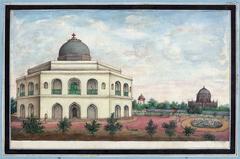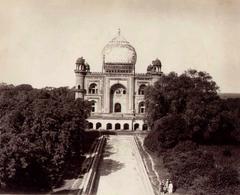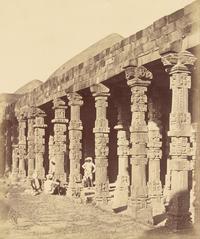Complete Guide to Visiting Zafar Mahal in New Delhi
Publication Date: 24/07/2024
Introduction to Zafar Mahal
Zafar Mahal, located in the Mehrauli area of New Delhi, is an often overlooked yet historically rich monument that encapsulates the grandeur and decline of the Mughal Empire. Built in the late 18th century by Mughal Emperor Akbar Shah II and later expanded by Bahadur Shah Zafar II, the last Mughal emperor, Zafar Mahal is a testament to the architectural and cultural zenith of the Mughal dynasty. This guide provides a comprehensive overview of Zafar Mahal, including its historical significance, architectural features, visitor information, and practical tips for making the most of your visit.
The palace is not just an architectural marvel but also a significant cultural and religious site. It is closely associated with the Dargah of Hazrat Khwaja Qutbuddin Bakhtiyar Kaki, a revered Sufi saint, making it a place of spiritual importance (News9Live). Additionally, the annual Phool Walon Ki Sair festival, initiated by Bahadur Shah Zafar II, celebrates communal harmony and is a testament to the syncretic culture of the time (The Hindu). Despite its rich history, Zafar Mahal is in a state of neglect today, suffering from vandalism and unauthorized constructions. Efforts by the Archaeological Survey of India (ASI) to restore and preserve this monument are ongoing but face significant challenges (Hindustan Times).
This guide aims to provide readers with detailed information about Zafar Mahal, including its history, visiting hours, ticket prices, and nearby attractions, to encourage more people to explore this hidden gem in Delhi.
Contents Overview
- Introduction
- History of Zafar Mahal
- Origins and Construction
- Cultural and Religious Significance
- Architectural Features
- Decline and Current State
- Visitor Information
- Special Events and Tours
- Photographic Spots
- Legends and Myths
- Conclusion
- FAQs
History of Zafar Mahal
Origins and Construction
Zafar Mahal, located in the Mehrauli area of New Delhi, India, dates back to the late Mughal period. The palace was initially constructed in the 18th century by Mughal Emperor Akbar Shah II. The original structure comprised a single floor with a few rooms, open areas, the Moti Masjid, and the Naubat Khana (News9Live).
In the 19th century, Bahadur Shah Zafar II, the last Mughal emperor, expanded the palace. He added another floor and constructed the grand Hathi Gate, a three-story entrance designed to allow an elephant with a houdah (a seat for people) to pass through. This gate is one of the most notable features of Zafar Mahal, adorned with marble and inlays, and it provided a vantage point for the royal family to view processions (Hindustan Times).
Cultural and Religious Significance
Zafar Mahal holds immense cultural and religious significance. It was built adjacent to the Dargah of Hazrat Khwaja Qutbuddin Bakhtiyar Kaki, a revered Sufi saint. Every Islamic ruler of Delhi, including the Mughals, was a disciple of this saint. The proximity to the Dargah made Zafar Mahal not just a summer retreat but also a place of spiritual importance (News9Live).
Bahadur Shah Zafar II initiated the festival Sair-e-Gul Faroshan, also known as Phool Walon Ki Sair, in honor of the saint. This festival, which celebrates communal harmony, involves the offering of floral tributes at the Dargah and the nearby Yogmaya Temple, symbolizing the syncretic culture of the time (The Hindu).
Architectural Features
The architectural layout of Zafar Mahal is a testament to Mughal grandeur. The palace originally included several structures, many of which have not survived or have been overtaken by unauthorized constructions. Key features included:
- Diwan-e-Khaas: Located 30 yards northwest of Hathi Gate, this structure had a ground floor and a first floor, with stairs made of red stones.
- House of Mirza Babur: Built during Akbar II’s reign, this house was another significant structure within the palace complex.
- Baoli of Aurangzeb: Situated to the west of Zafar Mahal, this stepwell measured 130 feet by 36 feet and had a well 30 feet in diameter with 74 steps.
- House of Mirza Nili: Located 10 yards south of Aurangzeb’s baoli, this house had an arched entrance from the market side.
- Thana of Bahadur Shah Zafar: Found 50 yards south of Mirza Nili’s house, this structure was in ruins by 1920 (News9Live).
Decline and Current State
The decline of Zafar Mahal began with the fall of the Mughal Empire. Bahadur Shah Zafar II, who wished to be buried in the precincts of Zafar Mahal, was exiled to Rangoon (now Yangon, Myanmar) by the British, where he died. His unfulfilled wish adds a poignant note to the history of the palace (Hindustan Times).
Today, Zafar Mahal is a shadow of its former glory. Despite being an Archaeological Survey of India (ASI)-protected monument, it suffers from neglect and vandalism. Unauthorized constructions have encroached upon the palace grounds, and the structure is in dire need of restoration. Local residents lament the lack of consistent conservation efforts, noting that any maintenance work is often superficial and temporary (Hindustan Times).
Visitor Information
For those interested in exploring Zafar Mahal, here are some practical details:
- Visiting Hours: Zafar Mahal is open daily from 10:00 AM to 6:00 PM.
- Ticket Prices: Entry is free for both Indian and foreign visitors.
- How to Get There: The nearest metro station is Qutub Minar on the Yellow Line, from where you can take an auto-rickshaw or a cab.
- Nearby Attractions: While in Mehrauli, you can also visit the Qutub Minar, Mehrauli Archaeological Park, and the Dargah of Hazrat Khwaja Qutbuddin Bakhtiyar Kaki.
- Accessibility: The site has limited accessibility for visitors with mobility issues due to its historical nature and uneven terrain.
Special Events and Tours
Zafar Mahal is the focal point of the annual Sair-e-Gul Faroshan festival, which attracts visitors from around Delhi. While there are no regular guided tours specifically for Zafar Mahal, many heritage walks organized by local groups include it in their itinerary.
Photographic Spots
Zafar Mahal offers several picturesque spots for photography, including the grand Hathi Gate, the intricate marble inlays, and the scenic views from the upper floors. Visitors often capture the juxtaposition of the historic monument against the backdrop of modern Delhi.
Legends and Myths
Zafar Mahal is also enveloped in legends and myths. One such tale is that Bahadur Shah Zafar’s grave was left empty in the palace precincts after his exile. However, historians like Swapna Liddle have debunked this as a romanticized story. In family enclosures like these, the area around the grave would be paved with marble after a burial, and no space would have been left empty (Hindustan Times).
Conclusion
Zafar Mahal stands as a poignant reminder of the Mughal Empire’s final days. Its rich history, cultural significance, and architectural beauty make it a site worth visiting, despite its current state of disrepair. Efforts to restore and preserve this monument are crucial to maintaining the legacy of one of India’s most storied empires.
FAQs
-
What are the visiting hours for Zafar Mahal? Zafar Mahal is open daily from 10:00 AM to 6:00 PM.
-
Is there an entry fee for Zafar Mahal? Entry is free for both Indian and foreign visitors.
-
How can I reach Zafar Mahal? The nearest metro station is Qutub Minar on the Yellow Line. From there, you can take an auto-rickshaw or a cab.
-
Are there any special events at Zafar Mahal? Yes, the annual Sair-e-Gul Faroshan festival is held in honor of the Sufi saint Hazrat Khwaja Qutbuddin Bakhtiyar Kaki.
-
What nearby attractions can I visit? Nearby attractions include the Qutub Minar, Mehrauli Archaeological Park, and the Dargah of Hazrat Khwaja Qutbuddin Bakhtiyar Kaki.
-
Is Zafar Mahal accessible for visitors with mobility issues? The site has limited accessibility due to its historical nature and uneven terrain.
Call to Action
Plan your visit to Zafar Mahal and delve into the rich history of the Mughal era. Don’t forget to explore nearby attractions and partake in the cultural festivities. For more information on Delhi’s historical sites, check out our other articles and follow us on social media for updates.
Sources
- News9Live, 2023, ‘Zafar Mahal: Last and Forgotten Monument of the Mughal Empire’
- Hindustan Times, 2023, ‘Last Mughal Emperor’s Summer Palace in Dire Need of Restoration’
- The Hindu, 2019, ‘Phool Walon Ki Sair: A Festival of Flowers’


